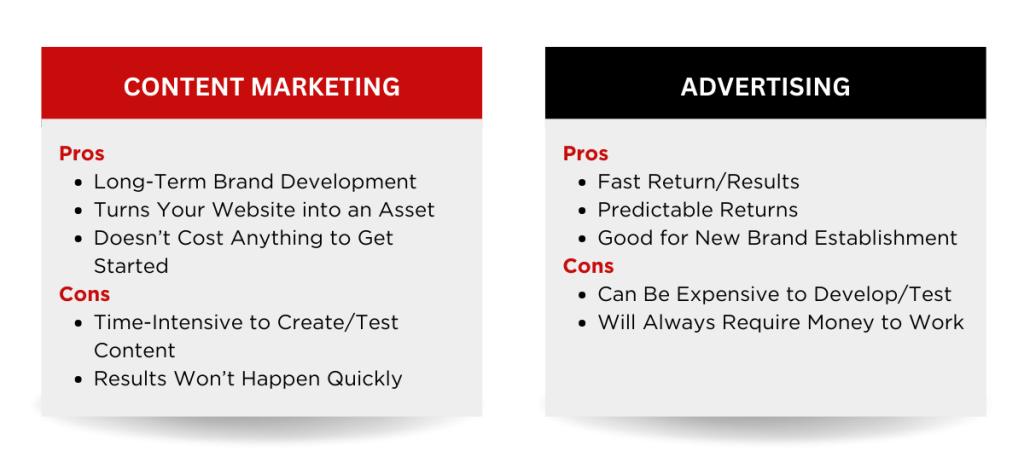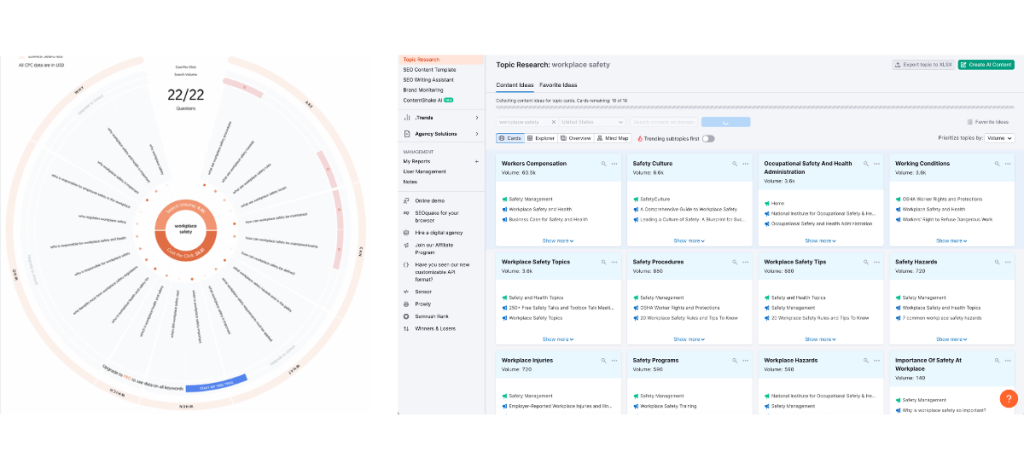BLOG
How B2B Brands Win at Content Marketing
Marketing has taken a major shift over the last several years. No longer confined to traditional methods, businesses are now leveraging content marketing to engage with their audience, build trust, and drive sales.
For B2B brands, this shift is not just a trend but a necessity. When it comes to marketing for B2B companies, content marketing focuses on delivering high-quality, strategic content that resonates with potential customers, addresses their pain points, and positions your organization as a thought leader in your industry.
Unlike traditional advertising, content marketing aims to provide useful information that educates, entertains, or inspires. This content can take various forms, including blog posts, white papers, eBooks, infographics, videos, podcasts, and social media updates.
Content Marketing vs. Advertising
Content marketing and advertising are two distinct strategies that serve different purposes but that support the ultimate goal of engaging prospects.
Content marketing is used to attract, teach, and entertain your audience with valuable, relevant content. It focuses on creating and sharing information that your audience finds helpful, which builds trust and positions your brand as an industry leader. In fact, 80% of all searches are for information intent, which is where your content marketing comes into play. We are seeking to answer the questions our audience is asking.
Advertising, on the other hand, relies on paid media to deliver quick, often immediate results. It works by distracting or interrupting your audience’s activities with promotional messages designed to capture their attention and prompt action. Advertising can be highly effective for new brand establishment and driving rapid engagement.

So, which one should you be using? Both of course!
You need paid advertising to get your brand, product, or service on the market. You need content marketing to create a deeper brand image that can eventually become a valuable resource to your customers.
Creating Your Content Strategy
There are 4 key steps to creating a content strategy that will help put you ahead of your competitors.
- Create Your Content Marketing Mission Statement
Your marketing mission statement is the reason why your audience should care. The three elements of your content mission statement include: Audience X + Information Y + Benefit Z To break this down even further, your content is going to be everything you create. You are creating content for audience X on the topic of information Y, with benefit Z being the reason they should care. Only 28% of marketers have documented their content mission statement, but it is proven time and again that those who document theirs succeed more than those who do not. - Develop Original Research
Two types of content that resonate best with audiences are original research and strong opinion pieces. Original research is accessible to anyone and involves finding and answering industry-specific questions or uncovering missing statistics. What is the answer your audience is seeking? Chances are if you are searching for the answer, someone else is too. - Repurpose Your Content
Consider repurposing your content mission statement into a powerful website, social media, or email marketing CTA to drive engagement. You can also repurpose any content you create into various materials. Consider a report you spent a lot of time working on – you don’t want to just end there. The data is in your hands! Turn the report into an infographic, write a press release, draft a social post, and send it out in an email blast. - Collaborate with Other Creators
Collaborating with influencers to create content with their input naturally attracts links and authority. Pitch this content to editors, media outlets, and industry blogs, and offer to rewrite your content from different perspectives to enhance originality, such as turning “5 Tips to Keep Your School Safe This Year” into “5 Mistakes Schools Are Making When It Comes to Student Safety.” Don’t forget to link back to the original piece to boost your authority score.
Digital Content and SEO Best Practices
There are many tools available to help you get started on your content creation journey, including:
- Google: The best source to search keywords and see what’s showing up; Google Suggest/Autocomplete allows you to see what your audience is searching
- SEMRush: Its topic research tools give you ideas for subjects to write about and also include keyword research for you to apply in your content itself
- Quora: A Q&A social platform where answers can be upvoted and help provide you with the content to answer these questions
- Answer the Public: Plug in a topic, and it will give you questions that it scrapes from the internet

Creating effective headlines for your content is key to attracting visitors; a headline that fails to catch the reader’s attention will simply be ignored. Visitors conduct a quick cost-benefit analysis before deciding to click, so it’s essential to use wording that immediately demonstrates value. When optimizing for search, be sure to meet people’s expectations and stay relevant, while on social media don’t be afraid to be a bit unexpected.
When crafting the perfect headline, be sure to start with your keywords – this is known as keyword prominence – and ensure your headlines are tailored appropriately for each channel. Google search favors titles with questions, while 11-word headlines perform well on social media. However, when it comes to articles, 14+ word headlines tend to get 3x more traffic, 2x more shares, and 5x more backlinks.
Beyond headlines, formatting your content to keep visitors engaged is key. Your audience isn’t reading everything, so huge, blocky paragraphs don’t work. Break up the text to enhance readability and maintain a smooth flow down the page. Don’t forget to link to other relevant content or pages across your website, as internal links not only keep visitors exploring your site but also improve your website’s SEO.
Bringing It Into Practice
In today’s competitive landscape, content marketing continues to be a powerful tool for B2B brands. By constantly offering valuable insights and solutions, you can nurture relationships with potential and existing customers, guiding them through the buyer’s journey and ultimately influencing their purchasing decisions.
Unlike traditional advertising, content marketing builds trust and authority over time. While it may require patience and effort to create and test content, the long-term benefits of establishing a strong brand presence and fostering customer loyalty make it a worthwhile investment.
To learn more about how Zer0 to 5ive can help drive visibility and industry leadership for your company drop us a line.
